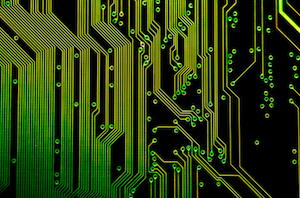A Definition of Printed Electronics
Printed electronics is an all-encompassing term for the printing method used to create electronic devices by printing on a variety of substrates. Originally, printed electronics related to organic or plastic electronics that use one or more inks made of carbon-based compounds. As demand for wearable devices and thinner electronics expands, printed electronics are being used to form flexible keyboards, antennas, electronic skin patches, and more. Printed electronics technology has evolved over time, and now inkjet printers are capable of printing electrical circuits quite inexpensively and quickly. In short, printed electronics is one of the fastest growing technologies today and is becoming invaluable to several industries including healthcare, aerospace, media, and transit.
Printed Electronics Applications
Printed electronics are being used in more products as the technology continues to advance. 
The market is catching up to the technology, according to Dr. Harry Zervos, principal analyst and business development manager for North America for IDTechEx: “The market for printed and flexible electronics is set to reach over $73 billion by 2025… Not all separate types of printed electronics will share equally in that big market – as I always say, printed electronics is an umbrella term and some markets will reach maturity sooner than others – but already, OLEDs, conductive inks in PV applications and printed glucose sensors are billion dollar markets that are set to grow.”
And, as Thin Film Electronics’ chief strategy officer Jennifer Ernst points out, the market for printed electronics is growing because the Internet of Things is expanding and requires low-cost, lightweight technology that can sense, store information securely, and transmit data. For these reasons, printed memory, sensors, and communications devices will play a part in the IoT market that is expected to reach $7.1 trillion by 2020.
Researchers continue to evolve printed electronics. For example, MIT engineers are working with a new type of printed electronics that involves an intricate printing process and stamping technique capable of printing transistors small enough to control individual pixels in high-resolution displays and touch screens. These engineers have succeeded in creating a stamp that prints electronic inks onto rigid or flexible surfaces. Their new printing technique delivers an inexpensive, fast way to manufacture electronic surfaces for applications that have yet to be created.
Benefits of Printed Electronics
Printed electronics have become secure, flexible, and cost-effective, all of which make them appealing to a broad range of industries. Printed circuitry has the potential to reduce costs and technical constraints typically associated with mass producing electronics. Printed electronics also require fewer input materials and less energy to work with them. And, printed electronics pave the way for flexible devices that people previously may not have thought possible. For example, companies are working on using printed electronics for identifying banknotes, credit cards, legal documents, and other items with unique printed signatures. Another industry benefiting from printed electronics advancements is photovoltaics. Printed electronics have the potential to significantly change solar power projects, thanks to less expensive polymer electronics.
Overall, the benefits of printed electronics include
- Low cost
- Attractive and flexible form factor
- Ease of production
- Ease of integration
- Facilitating widespread development of non-conventional functional electronic devices including flexible displays, smart labels, animated posters, active clothing, and more
Challenges with Printed Electronics
Despite its status as a fast-growing field in technology, printed electronics is not without its 
A Final Thought on Printed Electronics
Printed electronics aid in making everyday objects smart. From antennas and sensors to displays and printed batteries, printed electronics are being integrated into paper, plastic film, fabric, metals, and 3D printed objects. Printed electronics are opening a host of possibilities for electronic device applications and are influencing a range of industries including healthcare, aerospace, media, and transit.
Images via Flickr by Creativity103 and InteractiveNewsprint

